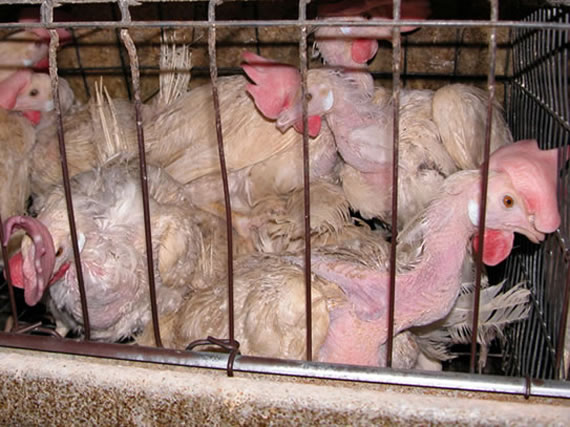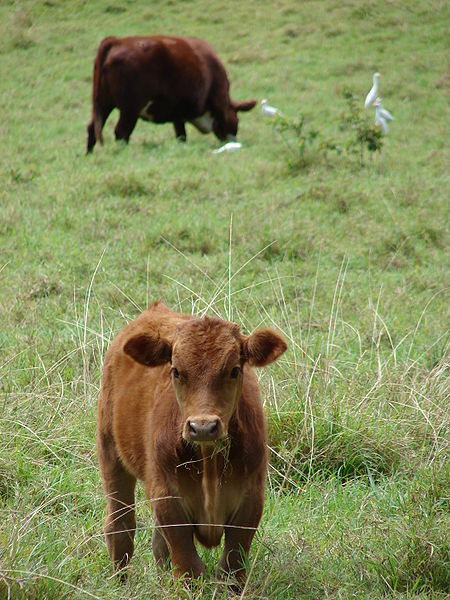 Ask nearly any school-aged child if cows, pigs, sheep, chickens, and other common farm critters are “animals,” and that child almost surely will tell you, “Yes!” Then she probably will giggle at your silliness or utter a bemused “Duh!!!” to mock your simplicity. Really, this question is a no-brainer…
Ask nearly any school-aged child if cows, pigs, sheep, chickens, and other common farm critters are “animals,” and that child almost surely will tell you, “Yes!” Then she probably will giggle at your silliness or utter a bemused “Duh!!!” to mock your simplicity. Really, this question is a no-brainer…
Except, that is, for the United States Department of Agriculture (USDA).
When it comes to protecting animals from cruelty, exploitation, and needless suffering at human hands, the Animal Welfare Act (AWA) is by far the primary piece of legislation. The Humane Methods of Slaughter Act (HMSA) is a second important federal code, along with individual regulations in different states and localities. But do not breathe a sigh of relief just yet.
Sadly, shockingly, strangely, the AWA only covers “dogs, cats, and certain other animals intended to be used for purposes of research or experimentation, and for other purposes” (AWA Final Rules, 1989). That is, farmed animals (animals used for food) are not explicitly covered by the AWA. Here is how the USDA defines an “animal”; be sure to notice the exclusion:
Animal means any live or dead dog, cat, nonhuman primate, guinea pig, hamster, rabbit, or any other warmblooded animal, which is being used, or is intended for use for research, teaching, testing, experimentation, or exhibition purposes, or as a pet. This term excludes: Birds, rats of the genus Rattus and mice of the genus Mus bred for use in research, and horses and other farm animals, such as, but not limited to livestock or poultry, used or intended for use as food or fiber, or livestock or poultry used or intended for use for improving animal nutrition, breeding, management, or production efficiency, or for improving the quality of food or fiber. With respect to a dog, the term means all dogs including those used for hunting, security, or breeding purposes.
And the HMSA is not much help. It does not apply to poultry at all, nor fish. Further, it has nothing to say about how the animals are raised, only about how they are slaughtered. Nor are individual state or locality regulations any better, since they have similar exemptions for farmed (“food”) animals.
The dark truth about farmed “animals”
If these exceptions do not bother you very much, then just consider: The bulk of farmed animals are raised on factory farms, transported in stress-causing transport vehicles, and/or processed in assembly-line-like processing plants. Nowadays, the idyllic image of a happy farmer happily tending his happy cows, pigs, chickens, and horses is not only naïve but laughable.
I doubt I need to go into the details of factory farms and the truly tortuous conditions that animals must endure there. (If you are interested, you can find ample material at the following factory-farming pages: the Humane Society, PETA, and Farm Sanctuary.)
 But just imagine being crammed into a cage with enough “personal space” for your body, with three or more others just like you, on wire floors that shred your feet, with your mouth parts (which is your primary sense organ) burned or cut off, in a stack of three to five cages, in a building with tens of thousands of your fellows…
But just imagine being crammed into a cage with enough “personal space” for your body, with three or more others just like you, on wire floors that shred your feet, with your mouth parts (which is your primary sense organ) burned or cut off, in a stack of three to five cages, in a building with tens of thousands of your fellows…
Governing bodies and independent research organizations around the world have recognized both the cruelty and harmful effects of factory farms. For example, the independent Pew Commission on Industrial Farm Animal Production is a project of The Pew Charitable Trusts and the Johns Hopkins Bloomberg School of Public Health, which was chaired by former Kansas Governor John Carlin and included former U.S. Agriculture Secretary Dan Glickman. The Pew Commission issued a study in which they clearly concluded that the cages and crates used by factory farms should be phased out:
After reviewing the literature, visiting production facilities, and listening to producers themselves, the Commission believes that the most intensive confinement systems, such as restrictive veal crates, hog gestation pens, restrictive farrowing crates, and battery cages for poultry, all prevent the animal from a normal range of movement and constitute inhumane treatment. (See “Putting meat on the table: industrial farm animal production in America“)
Sadly, some products that seem to be more humane often are not, thanks to significant labeling loopholes:
- “Certified humane” does not require animals to have access to the outdoors, and pigs can have their tails cut off without painkillers.
- “Free-range” does not have a minimum time or space requirement for outdoor access, and it is only regulated for birds (not other animals raised for food).
- Organic still allows the standard practice of smothering male chicks at birth because they cannot lay eggs; organic certification would prevent an ill animal from being treated with antibiotics, even if they would cure the animal.
Why farmed animals need protection
Obviously, exempting farmed animals from the AWA leaves factory farms plenty of opportunity to put the animals’ welfare far behind profit and efficiency. This oversight is huge, considering that the AWA lays out very clearly that “The living conditions of animals must be appropriate for their species, in accordance with the standards of part 3 [of the AWA], and contribute to their health and comfort” (Final Rules pt. 1-2).
Obviously, a battery cage (for poultry), gestation crate (for pigs), or veal crate (for calves) in warehouse-like buildings are not “appropriate for [a] species” and conducive to health and happiness. Rather, these are conditions fit only for lifeless commodities, bio-widgets, numbers on a profit/loss spreadsheet…
Some nations and U.S. states are recognizing how inhumane modern factory farms are, providing models of compassion to legislators, corporate personnel, farmers, and citizens. The UK’s Farm Animal Welfare Council (FAWC) have established the “Five Freedoms” of animals, which provide clear guidelines for animal treatment and facility conditions:
- Freedom from hunger and thirst: providing ready access to fresh water and a diet to maintain full health and vigor.
- Freedom from discomfort: providing an appropriate environment, including shelter and a comfortable resting area.
- Freedom from pain, injury, and disease: prevention or rapid diagnosis and treatment.
- Freedom to express normal behavior: providing sufficient space, proper facilities, and company of the animal’s own kind.
- Freedom from fear and distress: ensuring conditions and treatment which avoid mental suffering.
Also, in the U.S., California passed a bill in 2008 to ban extreme confinement by 2015, as well as imported eggs from confined hens in other states; similar but less-sweeping measures were enacted in Michigan, Florida, Arizona, and other states, and Ohio is now working on strong measures with some gains and concessions from farmers (no new construction of egg farms that pack birds in cages, and to phase out the tight caging of pregnant sows within 15 years and of veal calves by 2017).
What can we do about cruelty to farm animals?
There are myriad ways that we can improve the conditions that farmed animals have to live through, as well as what they face and how they are treated at slaughter. The simplest would be to expand the AWA’s definition of “animal” to include all farmed animals, including fish, and not just research and companion animals. Similarly expanding the HMSA to include poultry and fish would be an important next step.
These measures would bring them under the umbrella of protection from cruel abuse and handling, from unnatural confinement and unhealthy living conditions, from stress-inducing and unregulated transport, and cruel methods of slaughter. As such, battery cages or other extreme enclosures, debeaking, genetic and behavioral manipulation, and confinement with no access to the outdoors would become not only deplorable…but illegal as well. Making this federal law the baseline that all states and localities must, at a minimum, adhere to would be a great step towards ending the cruel treatment of the animals we rely on, and “know,” most directly.
Such a revolution in the USDA’s recognition and protection of farmed animals is still a long way coming, though. Worse, these and other legislation often have loopholes or enforcement problems, among other things, that reduce their efficacy and viability. (This issue is something I have personally committed myself to and am working on…so please stay tuned!) Until these changes to the AWA and other animal-protection laws occur, or until we find other ways to protect farmed animals, the only thing we can do with certainty is to become conscientious citizens and shoppers…and, of course, to go vegan.
Children know that farmed animals are animals. And most adults do, too, if only they will open their hearts. Then, it will be easy for us to recognize that all animals deserve equal consideration and a life without intentional, unnecessary harm…and that we owe them more than a miserable life in a factory.

Image credits: 1) Forest and Kim Starr, from Wikimedia Commons, under a Creative Commons License. 2) Ethelred, from Wikimedia Commons, under a Creative Commons License. 3) Youngbohemian, from Wikimedia Commons, public domain image.
Ready to leave farmed animals off of your plate? Take a look at some of our current vegan and vegetarian natural food offerings, including rice and beans, nuts, and vegan meat substitutes.


colluvial
I think meat-eating lies at the root of a lot of cognitive dissonance. People eat meat because they find it tastes good, viewing it as just a culinary choice. But, at the same time, they often have an emotional response to predation as being evil (take note of the ominous music that accompanies a predator stalking its prey in a nature documentary). In order to be able to pursue this dietary path, people have to demote food animals to unthinking, unfeeling agricultural products, especially when the methods used for raising slaughtering these animals is so brutal. Because their only interaction with these “products” is picking up packets of their flesh in the supermarket, there is no reason to think otherwise. On the other hand, in cases where people have direct experience with animals as pets, they have many of the same feelings as they do for other humans.
Justin Van Kleeck
Hey there colluvial, and thank you for the comment. I agree with you, obviously, about the perplexing paradox of how humans relate to animals as food. It is so troubling to see how the majority of people support animal welfare and humane treatment, yet continue the same old dietary and consumer habits. It really boils down to self-imposed blindness and forced forgetting. The truths are too horrid to confront, so they are hidden away. If this seems like a strong statement, try showing anyone some pictures or video from a factory farm. Better yet, take a few carnivorous friends and try to tour a factory farm. It will not happen–not because of “bio-security” (as the companies will tell you), but because the truth of what goes on would mean a complete loss of customers and so profits. The only really promising way to change this, I think, is to remind people that farmed animals are not “bio-widgets” (my term) but living, breathing, feeling beings who deserve as much consideration as the dog or cat (if not more). I think most people do care about animals, at least enough to support humane treatment, and sometimes they need to be reminded of that and not let convenience or habit conquer compassion and morality.